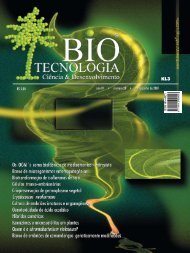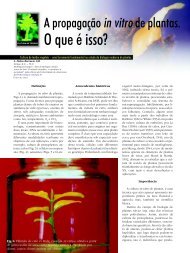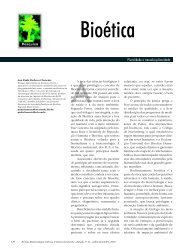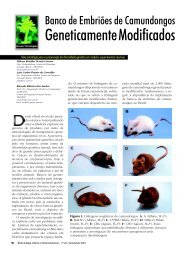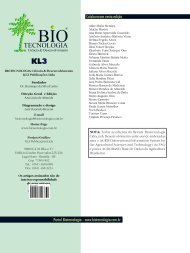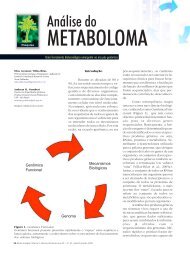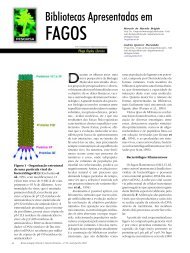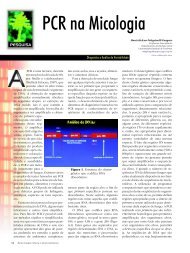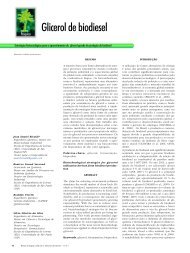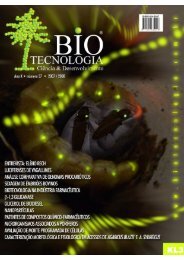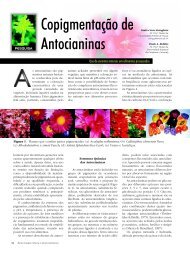Untitled - Biotecnologia
Untitled - Biotecnologia
Untitled - Biotecnologia
Create successful ePaper yourself
Turn your PDF publications into a flip-book with our unique Google optimized e-Paper software.
susceptível, possui um nível de<br />
resistência superior, em pelo menos<br />
100 vezes, ao padrão isogênico<br />
parental susceptível original.<br />
O emprego deste novo modelo<br />
será de grande impacto na análise<br />
das diferenças genéticas e fisiopatológicas<br />
presentes nos animais<br />
resistentes e susceptíveis. A identificação<br />
de alvos preferenciais,<br />
para o desenvolvimento protocolos<br />
visando combater a doença,<br />
auxiliará aos cientistas e às sociedades<br />
que os congregam, no entendimento<br />
de doenças causadas<br />
por protozoários, resultando em<br />
benefícios para a população.<br />
REFERÊNCIAS<br />
BIBLIOGRÁFICAS<br />
ANDRADE V, BARRAL-NETTO M,<br />
ANDRADE SG; (1985); Patterns<br />
of resistance of inbred mice to<br />
Trypanosoma cruzi are determined<br />
by parasite strain. Braz.<br />
J. Med. Biol. Res. 18 (4); p.<br />
499-506<br />
BAILEY, D.W. 1971, Recombinant<br />
inbred strains. Transplantation.<br />
v. 11 n.3, p. 325 -327.<br />
BEALL, J.R., TORNING, F.E. &<br />
RUNKLE, R.S. 1971. A laminar<br />
flow system for animal maintenance.<br />
Lab. Anim. Scien. v.<br />
21, p. 206 - 212.<br />
BRENER, Z.; (1980); Immunity to<br />
Trypanosoma cruzi; Adv. Parasit.<br />
18; p. 247 – 291<br />
COSTA F., FRANCHIN G., PEREI-<br />
RA-CHIOCCOLA V.L., RIBEI-<br />
RÃO M., SCHENKMAN S. &<br />
RODRIGUES M.M. (1998). Immunization<br />
with a plasmid<br />
DNA containing the gene of<br />
trans-sialidase reduces Trypanosoma<br />
cruzi infection in mice.<br />
Vaccine. 16(8); p. 768-774<br />
CUNHA NETO, E. (1999). Doença<br />
de Chagas. <strong>Biotecnologia</strong> Ciência<br />
e Desenvolvimento (9)<br />
p. 20 – 22.<br />
DILLEHAY, D.L., LEHNER, N.D.M.<br />
& HUERKAMP, M.J. 1990. The<br />
effectiveness of a micro isolator<br />
cage system and sentinel<br />
mice for controlling and detecting<br />
MHV and Senday virus infections.<br />
Lab. Anim. Scien. v.<br />
40, p.367 - 370.<br />
EKSI, S.; WASSON, D.L. & POWE-<br />
LL, M.R. (1996). Host genetics<br />
and resistance to acute Trypanosoma<br />
cruzi infection in mice:<br />
profiles and compartmentalization<br />
of IL-2; IL-4; IL-5; IL-10 and<br />
IFN-gamma-producing cells. J.<br />
Parasitol. 82(1); p. 59 – 65.<br />
GODARD, A.L. & GUENET, J.L.<br />
(1999). Genética de camundongos.<br />
<strong>Biotecnologia</strong> Ciência &<br />
Desenvolvimento (9) p. 96 –<br />
100.<br />
GOLDENBERG, S. & KRIEGER,<br />
M.A. (1997). Doença de Chagas<br />
<strong>Biotecnologia</strong> Ciência & Desenvolvimento<br />
(3) p. 26 – 27.<br />
MACEDO, A. M. & PENA, S.D.J.<br />
(1998). Genetic variability of<br />
Trypanosoma cruzi: Implications<br />
for the pathogenesis of Chagas<br />
disease. Parasitology Today.<br />
14(3) p. 119 – 124.<br />
MENENDEZ, R.C. 1985. Animales<br />
de laboratorio en las investigaciones<br />
biomédicas. Cuba, La<br />
Habana Editorial. Ciencias Medicas.<br />
p 203.<br />
MINOPRIO, P.; ITOHARA, S.;<br />
HEUSSER, C.; TONEGAWA, S.<br />
& COUTINHO, A. (1989); Immunobiology<br />
of Murine T. cruzi<br />
infection: The predominance<br />
of parasite-nonspecific responses<br />
and activation of TCR I T<br />
cells. Immunol. Rev. 112; p.<br />
183 – 207<br />
MOULIA, C.; Le BRUN, N. & RE-<br />
NAUD, F. (1996). Mouse-Parasite<br />
Interactions: from gene to<br />
population. Adv. Parasitol. 38,<br />
p. 119 – 167.<br />
PARASCANDOLA, J., B. 1994. The<br />
History of Animal Use in the<br />
Life Sciences IN: The world congress<br />
on alternatives and animal<br />
use in the life sciences:<br />
education, research, testing.<br />
Alan M. Goldberg and LFM Von<br />
Zutphen (Eds.). Mary Ann Liebert,<br />
Inc. publishers.<br />
PATON, W. 1984. Man and mouse.<br />
Animals in medical research.<br />
Oxford University Press.<br />
Oxford. ROTHSHIELD, M.A.<br />
1990. Manual para técnicos<br />
de bioterismo. São Paulo,<br />
Epm, Finep. p. 220.<br />
SHIROISHI, T., & YONEKAWA,<br />
H. 1994. Genetic differentiation<br />
and geographical distribution<br />
of various subspecies of<br />
mice IN: Genetics in wild mice<br />
- its applications to biomedical<br />
research. Edited by - Kozuo<br />
Moriwaki. Japan Scientific<br />
Societies Press.<br />
SILVER, L.M. 1995. Mouse Genetics<br />
concepts and applications.<br />
Oxford University Press,<br />
England. 1-362<br />
SOARES, M. B. P.; PONTES-DE-<br />
CARVALHO, L & RIBEIRO-<br />
DOS-SANTOS, R. (2001). The<br />
pathogenesis of Chagas’ disease:<br />
when autoimmune and<br />
parasite-specific immune responses<br />
meet. An. Acad. Bras.<br />
Cienc. 73 (4); p. 547 – 559.<br />
TRISCHMANN, T. M. ; (1984);<br />
Single Locus in BXH-2 mice<br />
responsible for inability to control<br />
early proliferation of<br />
Trypanosoma cruzi. Infec.<br />
Immun. 46; p. 658 – 662<br />
WANDERLEY, D.M. & CORRÊA,<br />
F.M. (1995); Epidemiology of<br />
Chagas’<br />
Heart Disease; Rev. Paul. Med.<br />
113 (2); p. 742 – 749<br />
W.H.O. (1991); Control of Chagas<br />
Disease. WHO. 187; p.1<br />
WIZEL B., GARG N., TARLETON<br />
R.L. (1998); Vaccination with<br />
Trypomastigote Surface Antigen<br />
1-Encoding Plasmid DNA<br />
Confers Protection against Lethal<br />
Trypanosoma cruzi Infection.<br />
Infection and Immunity.<br />
66 (11); p. 5073-5081<br />
WRIGHTSMAN R.A., KRASSNER<br />
S.M., WATSON J.D., MAN-<br />
NING J.E. (1984); Role of the<br />
H-2 s Haplotype in Survival of<br />
Mice after Infection with<br />
Trypanosoma cruzi. Infection<br />
and Immunity. 44(2); p.<br />
351-354<br />
<strong>Biotecnologia</strong> Ciência & Desenvolvimento - nº 29 31



